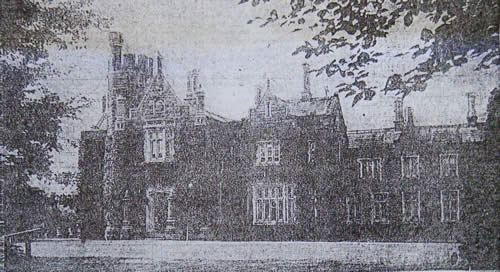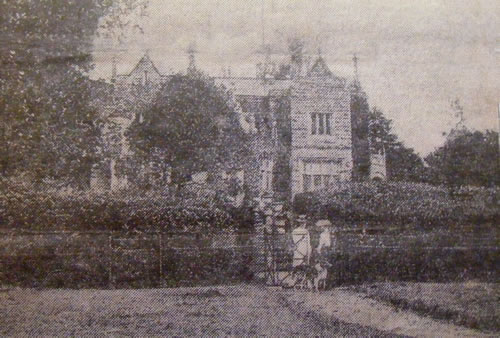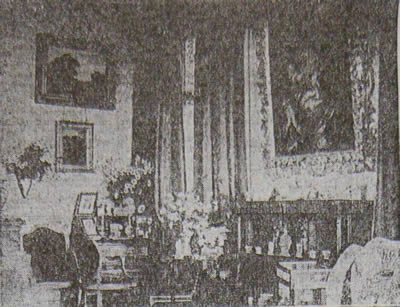Malpas Court
Article from “South Wales Daily News” March 23rd 1912
WELSH COUNTRY HOMES
- o -
CXIX – Malpas Court
--
A GWENT BEAUTY SPOT
--
Interests of the Mansion
--
ITS CERAMICS AND FURNITURE
--
A Veteran Oarsman’s Fine Record
--

Malpas Court from the North East
A couple of miles north of Newport the Pontypool road skirts the eastern side of a spacious park which extends for the space of nearly half a mile from the roadway westward to the Monmouthshire Canal. In the heart of this beautifully wooded enclosure stands Malpas Court, the home of Mr FTE Prothero.
The family have long been connected with the land of Gwent. In the 18th century the great-grandfather of the present owner of Malpas Court was a well-known solicitor at Usk. The latter’s son, Mr Thomas Prothero, who was born in 1780, and who married a Miss Collins, of Ingestone, Herefordshire, lived for some time at the Friars, Newport. It was he who purchased the land which now forms the Malpas Estate, and he too who built Malpas Court between the years 1835 and 1838.
The Building of Malpas Court
Part at any rate of the present Malpas Estate belonged in the 18th century to a branch of the Kemeys family. The house in which they lived was a large one. It has been pulled down long ago, but it is stated to have stood close to the main road not far from the site now occupied by the lodge, and to have been a Queen Anne house of red brick.
When Mr Thomas Prothero, 80 years ago, had secured the land for his park he selected for his new home a much more attractive site. From the main road the land falls gently away in a south-westerly direction until about half-way across the park it descends much more abruptly to the canal, which winds picturesquely between the trees along the valley bottom. Just on the brow of the hill, in the centre of the park, a rounded spur of hill projects in a south-westerly direction, and it was on this site that Mr Thomas Prothero built the fine mansion in which his family have since resided. At that time the Monmouthshire Canal was a great waterway, and Mr Prothero, who owned about half the barges that plied upon it, brought the stone for his house down the canal from Breconshire. The architect, Mr Thomas Henry Wyatt, then a young man, would appear to have originally intended that the whole building should be of Bath Stone, for the sketch which he made of it is still preserved, but happily this idea was not carried out, and the Breconshire stone was utilised. The latter is of an unusual type. Two or three other houses were built of the same stone, and then the quarry was worked out. It has certainly stood the test of time well, for the external fabric of Malpas Court looks today as good as when it was built.
A Choice Environment

Malpas Court from the South East
It is a well designed house and the architecture is thoroughly Tudor. The dressed-stone window facings and mullions form a pleasant contrast to the rough surface of the rest of the exterior. Here and there are introduced features which are reminiscent of Llantarnam, and it is believed that Wyatt visited the old Morgan home when he was at work upon the designs of Malpas.
The drive which winds pleasantly down the hill from the main road takes a sweep to the south-west as it approaches the house, the main entrance of which is on the north-eastern side. The garden fronts of the house are to the south-east and south-west, and it is on these sides that the principal rooms are situated. The domestic offices are at the north-western end.
On the southerly side the ground descends somewhat steeply, and the south-eastern garden, which once sloped, is now terraced, this alteration having been carried out by the late owner, the Rev. Thomas Edward Prothero, about fifty years ago. From opposite the south-western side of the house flights of steps descend to the park, which, to the south and east is separated from the garden by a sunk fence. The views from the park are exquisite, for they embrace that tract of undulating landscape across Henllys which is backed by the round summit of Machen Mountain and the irregular contour, 1,374 feet above sea level, of Twyn Barlwm. The vegetation of the park is just what one might have expected, having regard to the favoured site. There are some magnificent beech trees, while nearer the house ilex, cryptomeria, deodora, cypress, and juniper attain exceptional size. Many of these trees were planted at the time that Malpas Court was built and are now in their prime.
Some Fine Old Furniture
Just about the time that Malpas Court was ready for habitation, in the year 1838, there was a famous sale of old furniture at the 14th century home of the Fiennes family, Broughton Castle, near Banbury. It is related that the builder of Malpas Court gave a relative of his carte blanche to go and purchase things. This was done and the fine old furniture which came from Broughton seventy years ago still adorns Malpas Court. But there were other antiques brought from Broughton beside the furniture, and these include the old glass which now forms a window in the outer hall. This glass is of 14th or early 15th century date, and the dress of the characters depicted is quite mediaeval in type. There are several hunting trophies on the walls. Over the archway leading to the main hall is the head of a North African buffalo, while on the wall opposite the painted window hangs a trophy of Zulu arms.
The hall at Malpas Court is a very fine apartment, oblong in shape, spacious, and on the whole well arranged, though the projecting gallery, of necessity, shuts out some of the light. It extends the full height of the building and is lit from a skylight at the top. The beauty of the hall, as seen from the entrance, is enhanced by three Tudor arches at its inner end, and beneath the right hand arch the broad and very prettily designed staircase ascends in three flights to the gallery, from which access is obtained to the upper floor.
A glance around the entrance hall at once brings you into touch with the cultured atmosphere that is such a characteristic of every part of Malpas Court.
Its Fine Collection of Ceramics
On every side objects of vertu meet the eye. There are many brackets on the walls and all are filled with china. The interests of the mansion are many, but perhaps its chief claim to note is the very large and varied collection of ceramics which it contains. The great bulk of this china has been in the possession of the family for many years. Nearly every great English pottery is represented, but what is perhaps especially notable is the fact that there are included many of the rarer and lesser known types of work turned out from these potteries. There is a lot of glorious old Worcester of the florid period of Joseph and John Flight and Flight and Barr. Then, too, there are the tea services of Plymouth and Salopian, and Swansea and Derby and other potteries. Bow and Bristol are also well represented, and so are Spode and Wedgewood, while there is some choice Lowestoft of a type that is very rarely seen. Nor is this collection confined to Great Britain, for there are some fine specimens of the great continental potteries and choice examples from the Orient. The quantity of china at Malpas Court is amazing. On every hand, in almost every room and even in the hall and on the staircase you find it, and there is a good deal which, for safety’s sake, is carefully packed away in cupboards.
The furniture of the hall includes a set of fine Stuart chairs, while in the recess by the staircase stands a wonderful old carved cabinet in two tiers. The lower portion is of early Italian work, while the upper, which rises to a handsomely carved pediment of the “interrupted” type, is evidently of the Restoration period. The pictures in the hall include a clever sketch by himself of the late Mr George Richmond RA, while on the opposite side of the hall is a fine old mezzotint of Lady Spencer the mother of the beautiful Duchess of Devonshire.
A Reminiscence of Charles II

A corner of the drawing room
The drawing-room which occupies the southern corner of the house, and which has windows on two sides, has many interests. As an apartment it is homely rather than stately, a distinction too seldom met with. Some of the furniture is of the Louis Quatorze period. A finely carved oak armoire provides the resting place for more china, both Worcester and Derby, the panels on which are exquisitely painted. Near at hand is an old Italian table, on which repose examples of figure china of Bow and Chelsea. In a glass topped cabinet table there are many notable family possessions, which include two of special note. One is a miniature of King Charles II, which was given by that Monarch to an ancestor of the family, Henry Lewis, of St Pierre, in acknowledgement of a service rendered at a critical period in the Monarch’s career. Another miniature with a tale to tell is of the young Pretender, by whom it was given to Thomas Lewis, of St Pierre. Of the latter, by the way, a small oil-painting hangs on the drawing-room wall just inside the door. It depicts him as a boy in his teens, but wearing a wig! On a side-table by the white marble fireplace are some fine examples of the goldsmith’s art – notably a pair of old German saltcellars, the work of DeBrie, of Frankfurt, and near it is a fine Ausburg tankard of 17th century date.
There are many attractive pictures. The latter include one of Nell Gwyn, while not far away is a fine sea-piece by Peter Monamy, a well-known painter in the first half of the 18th century. A large portrait of an unknown individual in 18th century attire is a fine example of Sir William Beechey’s work. There is a striking oil-painting of an old Dutch woman by Jansen.
On the north-eastern wall is a fine old water-colour believed to be by Francis Nicholson (1753-1844); it is supposed to represent High Force, Teesdale. Nicholson was a member of the Old Water-Colour Society and his pictures were held in high estimation.
In The Library
The library, which is a pleasant room, with an easterly aspect, is a favourite retreat of Mr Prothero. Its well filled shelves of well used books afford evidence of the literary interests of the Malpas household. Over the mantelpiece the place of honour is accorded to a sketch of Mr Prothero’s mother, who was a daughter of a former canon of Salisbury. Near the door hangs a small oil painting of the third Lord Holland. The whole of the space above the book-shelves on the north-eastern wall is taken up with a quaint picture, dating from the late 16th or early 17th century representing the town of Lubeck with its forest of lofty church spires and pigmy houses.
On the north-western side of the entrance is a cosy little study, on the walls of which are hung some nice prints, including a couple of fine Turner engravings, a Bartolozzi and several examples of the coloured stipple prints of the late 18th century.
The dining room, which is at the westerly end of the south-west front, contains many family portraits. One of these, which is by Zoffany, is of a maternal ancestor of Mr Prothero, a Mr Collins, a banker of the City of Salisbury, who had literary interests. He became a publisher, and in this capacity purchased for £10 a one-third share in Oliver Goldsmith’s “Vicar of Wakefield.”
A painting of especial interest is of Mr Thomas Prothero, the builder of Malpas Court, and there are others of Mr Prothero’s father, the late Rev. Thomas Edward Prothero, who was a chaplain-in-ordinary to the late Queen, and of his maternal grandfather.
Two of the walls in the dining room are occupied by 17th century Burgandian tapestries, which are in an excellent state of Preservation. The most notable of these represents the worship of Bacchus.
Some Rowing Prizes
All of his life Mr FE Prothero has been an enthusiastic oarsman. Of some of his exploits in this respect we shall have something to say later, but it may be noted in passing that on a side table by the dining-room are a nice collection of pewters, which were won by him in his Oxford days. To the right hand of the fireplace is a bookcase which is filled in great measure with books won by him as prizes at Eton. On the long wall of the dining-room, above the tapestry, are portraits of Paul Veronese, Rubens, Rembrant, and Sir Joshua Reynolds. When the late Mr Prothero was staying in Florence, half a century ago, he had these copied by an Italian artist, who afterwards became famous, from the originals in the Uffizzi Gallery. Two other paintings in the dining-room deserve, at any rate, passing mention, one being a small example of the work of Paul Wouverman, which, by the way, is not in such a good light as it deserves, while the other is a fine portrait of Sir Anthony Vandyck, which is understood to have been painted by a pupil in the great Dutch master’s studio.
The walls of the broad staircase at Malpas Court and the gallery above the hall present many interests. On brackets on the lower walls, and on stands in the corner of the landings, choice pieces of the ceramic art fill all available space.
Relic of a Dangerous Adventure
To the right hand, near the top, there hangs on the wall all that remains of a boat in which Mr Prothero travelled many miles on the rivers of Europe. This boat recalls one of the most dangerous of Mr Prothero’s many adventures. He was boating on the Aar when his frail craft was carried into a rapid. It would appear to have struck a submerged rock, for it smashed up and sunk beneath him and he had a hard swim ashore. The fragments of his boat were smashed to pieces in the torrent, and the piece which is still preserved as a relic was afterwards washed down into the lake of Bienne, and there recovered.
Probably no one else in Wales possesses the record that Mr Prothero does in the number of miles which he has rowed over the rivers of Europe. The Danube, the Rhine, the Weser, the Seine, and many others of the great waterways of the continent have been explored by him in his summer holidays during the past half-century. A photograph at the top of the stairs represents a favourite rowing boat, in which he went most of these trips, and round the margin is a record showing the rivers visited, and the number of miles rowed upon them between the years 1860 and 1903. One of his most notable trips was when he rowed on the Danube from Ulm to Pest, a distance of 589½ miles. On another occasion he traversed 350 miles on the Rhine, on another 220 miles on the Moselle. These are but a few of many such trips. Nor has Mr Prothero neglected our English rivers, for the Thames, and the Trent, and the Yorkshire Ouse, and many others have also been the scene of his relaxations in summer days.
Reminiscences of College Days
The walls around the gallery above the hall are covered with pictures, prints, and photographs of interest. There are interesting reminiscences of Mr Prothero’s school and college days. Near the top of the staircase is a sketch of his Eton tutor, the late Mr Edward Coleridge, the nephew of Samuel Taylor Coleridge, the poet, while from another wall the venerable, scholarly, yet kindly, face of Mr Jowett looks down upon you.
Malpas Court contains a very fine collection of old silver, but of this and of its many other interests space precludes further mention.
-o-